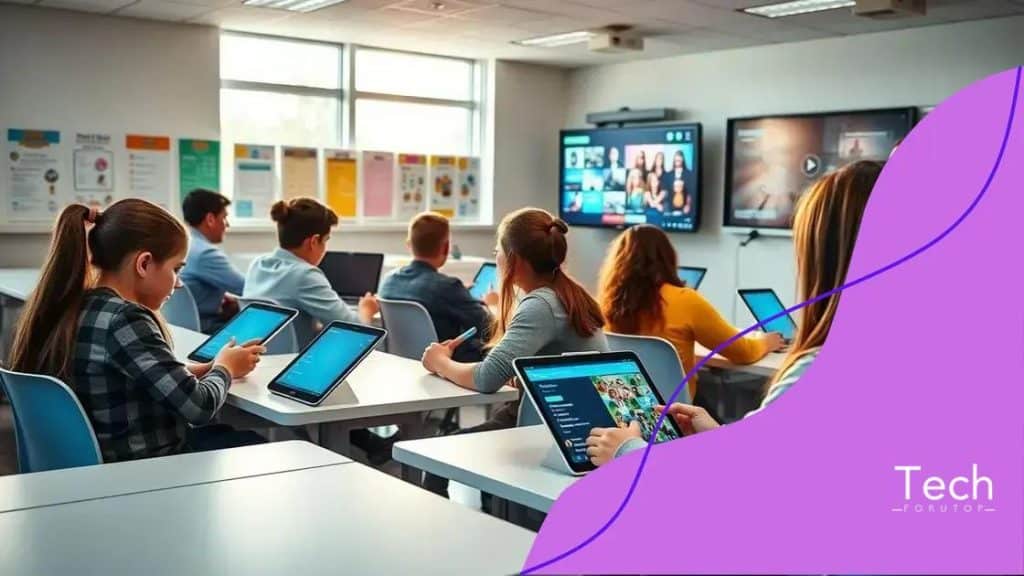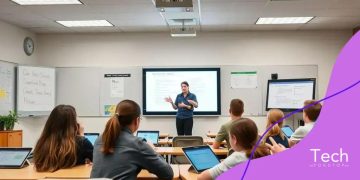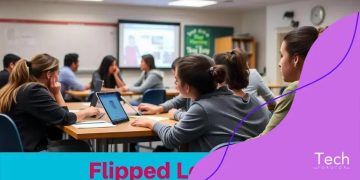AI in education: exploring benefits and risks

AI in education enhances personalized learning, supports teachers by automating tasks, promotes collaboration among students, and introduces risks such as data privacy concerns and algorithmic biases.
AI in education is transforming the learning landscape, bringing new possibilities and challenges. Have you ever wondered how these technologies could impact students and teachers? In this article, we’ll delve into this dynamic field.
Understanding AI in education
Understanding AI in education is essential for grasping its impact on modern learning. As technology evolves, educational institutions embrace various AI tools to enhance the teaching and learning experience.
AI can analyze student data and provide personalized learning pathways. This is where technology meets pedagogy, creating tailored experiences for individual learners. For instance, AI systems can identify learning gaps and recommend resources suited to each student’s needs. This capability is revolutionizing the way knowledge is delivered.
Key Features of AI in Education
Several features of AI contribute significantly to its effectiveness:
- Adaptive Learning: AI-driven platforms adjust to student performance, ensuring they receive appropriate challenges.
- Automated Administrative Tasks: AI can streamline administrative tasks, freeing teachers from paperwork to focus on teaching.
- Real-Time Feedback: AI enables immediate feedback on assignments, allowing students to reflect and improve quickly.
These features not only lighten the teachers’ workload but also enhance student engagement. As AI solutions become more sophisticated, they address diverse learning styles. This flexibility leads to better academic outcomes across various subjects.
Challenges and Considerations
While AI presents numerous advantages, it also brings challenges. Privacy concerns regarding student data are paramount. Schools must ensure they implement safe data handling procedures. Moreover, some educators worry about the potential over-reliance on technology. Striking a balance between using AI and maintaining traditional teaching methods is crucial.
Moreover, equity in access to AI tools is another concern. Not every school has the same resources, which can widen the educational gap. Schools must work on strategies to ensure all students can benefit from these advancements.
Ultimately, as AI continues to integrate into education, understanding its role, benefits, and implications can foster a more efficient learning environment.
Key benefits of AI technologies
Key benefits of AI technologies in education are numerous and transformative. These benefits enhance both teaching and learning processes, making education more accessible, efficient, and engaging.
One major advantage is personalized learning. AI can adapt to each student’s learning style and pace, providing tailored resources that cater to their needs. This means that students can learn more effectively, as they receive support that is designed specifically for them.
Enhanced Engagement
Another important aspect of AI is how it boosts student engagement. By using interactive tools and gamified learning experiences, AI makes education more enjoyable.
- Interactive Learning: AI tools provide simulations and games that help students grasp complex concepts.
- Real-Time Feedback: Students receive instant feedback on their performance, which encourages them to keep improving.
- 24/7 Accessibility: AI-powered platforms allow students to access learning materials anytime, promoting continuous learning.
These features keep students motivated and involved in their education. As learning becomes more interactive, students are more likely to stay curious and eager to learn.
Improved Efficiency for Educators
AI also reduces administrative burdens for teachers. By automating grading and other repetitive tasks, teachers can focus on what they do best—teaching.
This efficiency allows them to dedicate more time to direct student interaction and instructional planning. Moreover, schools can analyze data gathered by AI systems to improve educational strategies and outcomes. This data-driven approach leads to better decisions that support student success.
Incorporating AI into the classroom offers several advantages that can transform education for the better. Understanding these key benefits is essential for educators and institutions looking to harness the power of technology.
Identifying risks associated with AI

Identifying risks associated with AI in education is crucial for ensuring a safe and effective learning environment. As technology advances, it brings both benefits and challenges that must be openly addressed.
One of the primary concerns is privacy. AI systems often collect vast amounts of student data, raising questions about how that data is used and protected. Without proper safeguards, sensitive information can be exposed, leading to breaches of trust between students, parents, and schools.
Potential Bias and Inequality
Another significant risk is the potential for biases in AI algorithms. If the data used to train AI systems is not diverse or inclusive, it can lead to unintended consequences. This bias can affect how students are evaluated and the opportunities they receive.
- Discrimination: AI may favor certain demographics over others, leading to unfair treatment.
- Reduced Opportunities: Students from underrepresented backgrounds may not receive the same advantages as their peers.
- Reinforced Stereotypes: AI can unintentionally support existing stereotypes in its recommendations and assessments.
Moreover, there is the issue of over-reliance on AI technologies. If educators depend too heavily on AI systems, essential human elements of teaching may be lost. This could hinder the development of critical thinking and interpersonal skills in students.
Potential Job Displacement
As AI continues to evolve, concerns about job displacement for educators also arise. While AI can enhance learning, educators might fear losing their roles in favor of automated solutions. It’s vital to find a balance where AI complements rather than replaces the human touch in education.
Finally, implementing AI can involve significant costs and complexities, which might not be feasible for all schools. Budget constraints can lead to uneven access to advanced technologies, potentially widening the educational gap. Addressing these risks is paramount for maximizing the potential of AI in education.
Real-world examples of AI in classrooms
Real-world examples of AI in classrooms showcase the tangible benefits and innovative applications of this technology in education. Many schools and universities around the world are already integrating AI tools to enhance learning experiences.
One notable example is the use of Intelligent Tutoring Systems. These systems provide personalized learning opportunities for students. For instance, platforms like Carnegie Learning offer tailored math tutoring that adjusts the difficulty based on student performance. This enables students to work at their own pace and master concepts effectively.
AI-Powered Assessment Tools
Another impactful application is AI-driven assessment tools. These tools help educators evaluate student performance more efficiently. Gradescope is one such tool that allows for quick grading of exams and assignments. It streamlines the grading process, providing insights into student understanding and helping teachers identify areas needing attention.
- Automated Feedback: Students receive immediate feedback on their work, which aids in their learning process.
- Data Analysis: Teachers can analyze trends and performance metrics easily, allowing for targeted instruction.
- Time-Saving: Educators spend less time on grading, freeing them to focus on teaching.
Additionally, many classrooms are adopting virtual learning assistants. Tools like Google Assistant or Amazon Alexa can help facilitate learning by answering questions, managing schedules, or providing information on various subjects. These AI assistants become an integral part of the learning environment.
AI in Special Education
AI is also making strides in special education. For example, tools that utilize speech recognition technology can assist students with communication challenges. Applications like Voiceitt translate unintelligible speech into clear communication, helping students express their thoughts.
Furthermore, schools are exploring the use of AI-driven analytics to track student progress. By analyzing data, educators can develop targeted interventions for students who may be struggling. This data-driven approach can significantly improve educational outcomes.
These examples illustrate the potential of AI to transform classrooms, making education more personalized, efficient, and accessible for all students. As technology continues to advance, the applications of AI in education will likely expand even further.
Future of AI in education
The future of AI in education holds exciting possibilities that can change how we think about teaching and learning. As technology continues to evolve, education will also adapt to include innovative AI tools tailored to meet the needs of students and teachers.
Anticipating these changes, many educational institutions are beginning to explore how AI can further personalize learning experiences. With advancements in machine learning, AI systems will become even better at understanding individual learning styles and preferences.
Personalized Learning Journeys
One significant development is the use of AI to create personalized learning paths for students. By analyzing performance data, AI can recommend resources, exercises, and assessments that cater to each student’s unique pace.
- Customized Content: AI can curate learning materials based on interests and strengths.
- Predictive Analytics: AI can predict future performance and suggest interventions before issues arise.
- Adaptive Learning Platforms: Tools like DreamBox or Khan Academy are already integrating adaptive learning technologies.
This level of customization helps ensure that every student maximizes their potential and receives the support they need.
AI-Enhanced Teacher Support
Another exciting aspect of AI’s future in education is its potential to assist teachers. AI can handle administrative tasks such as grading and scheduling, allowing teachers to focus more on instruction and interactions with students.
Furthermore, AI tools will provide data-driven insights, helping educators make informed decisions about curriculum and teaching strategies. That way, teachers can dedicate more time to fostering student engagement and less time on routine paperwork.
Collaborative Learning Environments
AI will also play a role in creating collaborative learning environments. Virtual classrooms powered by AI can facilitate interactions between students from different backgrounds and locations. These AI-driven platforms will enable meaningful discussions and exchanges of ideas, providing opportunities for collaboration.
Moreover, we may see the rise of intelligent education assistants that can help students with queries in real-time or even mentor them through challenges. This support could bridge gaps in learning, particularly in remote or underserved areas.
Overall, the future of AI in education looks promising, offering potential solutions to enhance learning experiences for students and support educators effectively. Schools must continue to embrace these innovations while addressing the challenges that accompany them.
FAQ – Questions about AI in Education
How does AI personalize learning experiences?
AI analyzes student data to create customized learning paths, ensuring that each student receives support tailored to their individual needs.
What role does AI play in supporting teachers?
AI helps teachers by automating administrative tasks and providing insights from data analysis, allowing them to focus more on teaching and student interaction.
What are the potential risks of using AI in education?
Potential risks include privacy concerns regarding student data, biases in AI algorithms, and challenges related to equitable access to technology.
How can AI enhance collaboration in the classroom?
AI can facilitate collaborative learning through virtual platforms that connect students from diverse backgrounds, promoting shared learning experiences.





